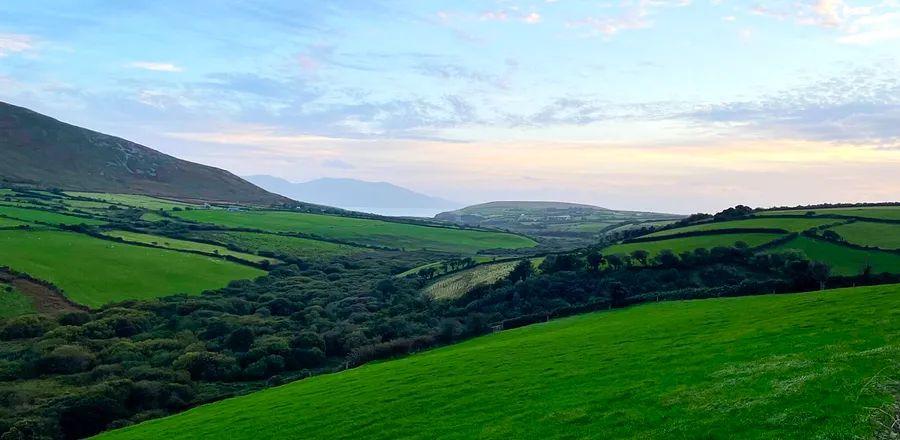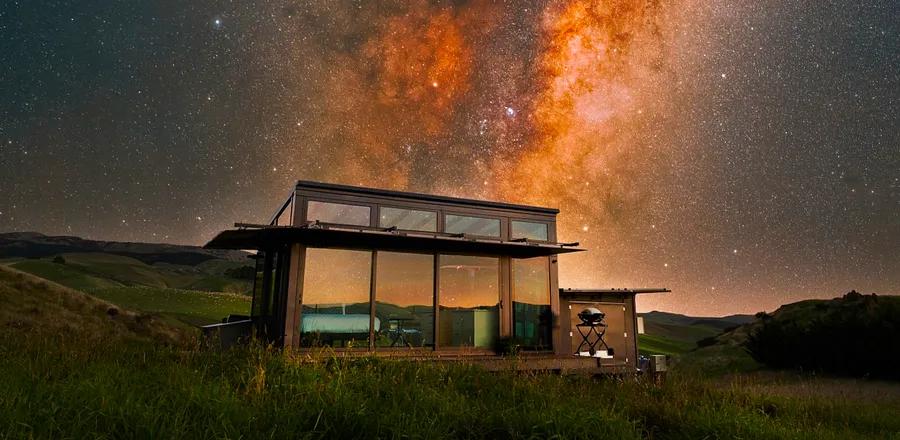Journeying with a TV Star: My Bare Feet Adventure in Ireland

With its striking blue cinderblock facade and vintage Guinness sign by the entrance, Neligan’s perfectly captures the charm of a classic Irish pub. It bears a striking resemblance to many pubs on Main Street in Dingle, a creative town in County Kerry known for its vibrant food scene. Yet, it was the lively sound from Neligan’s that made it stand out amidst the sea of beer advertisements and Celtic designs: the blend of accordion melodies and rhythmic footsteps, along with directions shouted in Irish, floated out the front door. Neligan’s hosted a céili, a traditional Irish dance night that takes place weekly. This wasn’t a tourist performance; it was packed with locals who all seemed to know one another as the crowd ebbed and flowed. People came in for dancing, drinks, and conversation before moving on. It was just a regular weekday, after all.
An older gentleman played the accordion against a wall devoid of windows. Occasionally, a singer or fiddler would join him. Between sets (while the band took a break for drinks), patrons wandered the cozy space seeking a dance partner. There was no chance to hide. A young woman in a long-sleeved floral dress and motorcycle boots approached me, inviting me with a warm wave to the dance floor. This was Niamh Varian-Barry, a traditional violinist and singer, whom I would formally meet the next day when she and her husband performed for us in a parlor above another pub.
“Do you want to take the lead?” she asked. I admitted I was clueless, so I politely declined.
“It’s really simple,” Niamh reassured me. “You’ll do great.”
“One, two, three, four,” the caller counted, and we were off.
Dance after dance, song after song, people of all ages twirled, marched, shuffled, bumped into one another, and erupted with laughter. It was an immediate introduction to the local culture—a more effective icebreaker than most.
That’s the essence of Bare Feet, the award-winning dance travel series on PBS, which is why I’m joyfully colliding with strangers in Ireland. Mickela Mallozzi is the creator and host who—as the show’s intro highlights—“experiences the world one dance at a time.” Having studied ballet, jazz, and tap throughout her childhood, she taught dance for nearly a decade. When faced with language barriers during her travels, she conceived the idea of participating in festivals and cultural events; there, she would join in public dances that often led to new friendships and invitations to local homes or private gatherings. Building on the success of her show, she launched Bare Feet Tours in 2014, starting with a Balinese dance tour. In 2017, she expanded to a tango journey in Argentina.
“I quickly realized this is a fantastic way to travel and a simple means to connect with locals right away,” Mallozzi shares. “I created the Bare Feet Tours so that people could enjoy a truly immersive and accessible travel experience.”

Photo by Mickela Mallozzi
I participated in the inaugural Bare Feet Ireland tour in May 2022, an enriching journey that took us through Dublin, Ennistymon, and Doolin in County Clare, as well as Dingle and Killarney in County Kerry over the course of nine days.
I can’t recall the last time I attended a dance class—or any class that wasn’t online due to the pandemic. Signing up for three Irish dance classes in a week while on a bus tour across Ireland felt quite ambitious. During that time, we were promised lessons in traditional Irish step dancing, set dancing, and sean-nós dancing. I envisioned a group of semi-professional dancers arriving in trendy workout attire that would outshine TikTok influencers. Instead, I encountered 10 wonderfully ordinary people eager to explore Irish arts and culture. We danced in jeans, sneakers, leggings, sweaters, clogs—whatever we happened to be wearing that day.
My 10 travel companions ranged widely in age and life experience, from their late 20s to late 50s. Margaret, Bobbi, Daniel, and I were the four solo adventurers. Bobbi had traveled with Bare Feet Tours before. Sofia and Julian, hailing from Pennsylvania, loved to dance when not juggling bicoastal business roles. Kim, her sister Stephanie, and Stephanie’s husband Bruce all worked in the ice cream industry in Oregon. Byron joined his sister Brighid (a dance major at NYU) on the tour after their parents had to stay home due to COVID quarantines. Everyone in our group was a fan of the show.
Acquiring new skills alongside a group of strangers during the first real vacation many of us had taken in years was a wonderful bonding experience. Naturally, some were more adept dancers than others, but here we were, a mismatched crew in Ireland, striving to learn something relatively unfamiliar to us all. Dancing proved to be an incredible way to connect. Each day, we found ourselves laughing at one another (in good spirits), impressing each other, or supporting one another on the dance floor.
That’s the essence of Bare Feet Tours. It’s not meant to be an exclusive dancing affair. Rather, it’s a lively cultural experience, enriched with some expert private dance lessons.
“We’ll be professionals in no time!”
The dance barn adjacent to Vaughan’s Pub in Kilfenora, County Clare, hosted some of the last remaining set dances in the country every Sunday from 1991 to 2020. Irish set dancing has its roots in the 18th century, influenced by French quadrilles and court dances. Four couples dance together in a “set,” weaving into shapes and patterns, then rotating positions (and sometimes switching partners). Although the barn was still closed to the public due to COVID, we enjoyed a private lesson with Aidan Vaughan, one of Ireland’s contemporary dance masters.

Photo by Mickela Mallozzi
As with all our classes, the professionals guided us first, and then Mallozzi stepped in to provide individual attention. She seemed to absorb new moves effortlessly, making the complex look simple and the learning process enjoyable, all while exuding her cheerful Type A personality. As my partner, she quickly helped me fine-tune my steps and timing. When it was my turn to dance with Vaughan, we settled into a waltz hold while waiting for everyone else to get into their spots. He surveyed the group with keen eyes, ready to kick off the dance.
“We’ll be pros in no time,” I quipped to lighten the mood.
Vaughan shook his head vigorously, then paused.
“No,” he replied, just to be clear.
“Perhaps in a few years,” he added tactfully.
Group dance classes are akin to karaoke: it’s more enjoyable when everyone is somewhat average yet fully committed.
A (tin) whistle-stop tour
In Doolin, County Clare, we visited Gus O’Connor’s pub, one of the most renowned venues for Irish music. There, we encountered Christy Barry, a talented Irish trad musician known for his mastery of the tin whistle—a small, shrill instrument reminiscent of a recorder. While it’s simple to pick up, mastering it is quite another challenge. Trad music has made Doolin a hotspot for tourists, with the town thriving as a result. Barry attempted to teach us a traditional tin whistle tune, but he underestimated our excitement. The sea breeze carried our eleven distinct interpretations far and wide, sending both people and seagulls scurrying away. Doolin may never recover from our performance.
Between our dancing sessions, we explored various parts of the country. Our guide and bus driver, Patrick Foley, kept us entertained all week with his extensive knowledge of Irish history and culture (and a few songs). Over the week, we spent about 12 hours on the bus, with the longest journey from Dublin to Clare. Approximately half of our time was free, during which Foley had recommendations at the ready, including an impromptu scenic drive around Slea Head on the Dingle Peninsula. Foley and Mallozzi also surprised us with a literary pub crawl in Dublin, a walking food tour and private trad session in Dingle, a self-guided bike tour of Killarney National Park, visits to several artisan shops, a meet-and-greet with a five-time World Champion Irish dancer at his family pub, and a festive performance banquet in Killarney.
Killarney marked the tour's final destination, where we were introduced to sean-nós (“old style”) dancing. Before Irish dance became more structured, it was spontaneous and free-flowing. Sean-nós involves a lot of shuffling and foot stomping, akin to clogging, tap dancing, or flatfooting. Unlike the rigid postures seen in Riverdance, sean-nós dancers allow the rhythm to guide their movements. This style typically doesn’t involve partners, except during a broom dance, where your partner is literally a broom, which you jump over, dance around, and ultimately kick over your shoulder for the grand finale.
Ireland brims with prehistoric sites, thatched-roof pubs, charming small towns, ancient stone churches, lush green fields, and stunning natural landscapes. It’s no surprise that this country attracts over 11 million visitors each year. While there’s much to explore, experiencing the culture through its music and dance offers a deeper connection. Ireland boasts a vibrant pub scene and a rich artistic heritage. After a year and a half of COVID restrictions, pubs reopened fully in spring 2022, allowing singing and dancing to return. During our visit, we encountered plenty of “modern” Irish dancing—often performed by exuberant teenagers—to live music in late-night pubs, which only emphasized the vibrant spirit of the culture.
Ireland is not a place for spectators. Sometimes, the best approach is to jump in headfirst.

1

2

3

4

5
Evaluation :
5/5